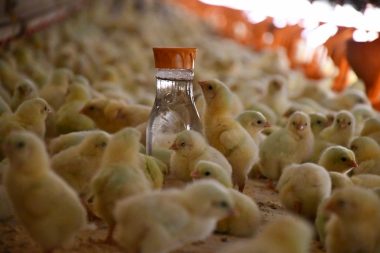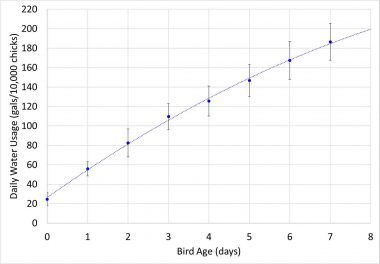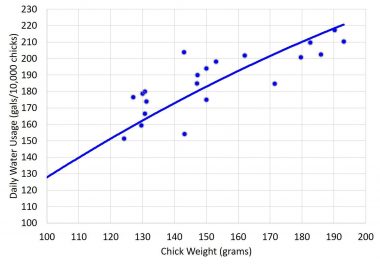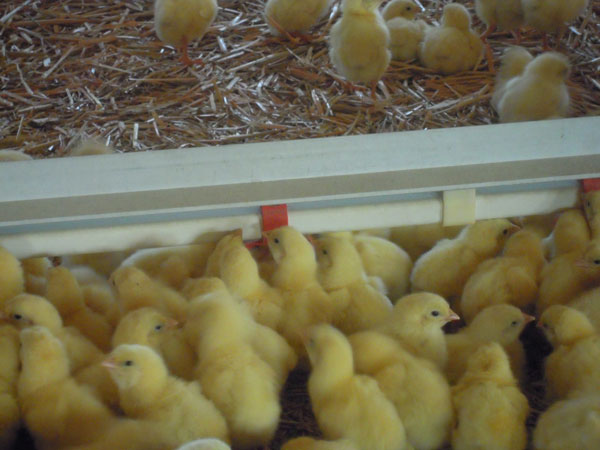From the moment of hatch, water is a critical factor in the growth of broilers. Precisely monitoring and measuring water consumption is an important tool to successfully raise a flock.
By Michael Czarick, Connie Mou and Brian Fairchild
University of Georgia
College of Agricultural and Environmental Sciences
Cooperative Extension
Athens, GA USA
Getting chicks off to a good start is very important to overall flock performance. At no time does a bird grow faster than during the first week of its life. Over the last week of a 42-day-old flock, a bird’s weight will increase by approximately a third. In contrast, a chick’s weight will typically increase approximately four fold, possibly more, by the time it reaches seven days of age. Of course, if a chick is going to grow this quickly it has to eat plenty of feed. Research has shown that over the first full day of a chick’s life it will eat approximately 1/4 of its weight in feed. By the end of the first week, a 40-gram chick (0.09 lbs) will eat approximately 150 gram (0.33 lbs) of feed and gain approximately 140 gram (0.31 lbs), giving it a feed conversion ratio (FCR) of approximately 0.5 kg (1.1 lbs) of gain/ lbs. of feed (Alqhtani, 2016).
This very high growth rate during the first week is only achievable IF the chicks have access to plenty of water. A chick will not eat, and therefore will not grow, if it cannot drink. In the previously noted study it was found that during the first few days of a flock, a chick will drink nearly three grams of water for every gram of feed. By the end of the first week each chick in a house will drink approximately 340 ml (12 ounces) of water (Figure 1). This is over eight times their initial weight in water.

Figure 1. A chick will drink approximately 12 ounces (340 ml) of water by the time it is seven days old
Water consumption measured
A study was conducted on commercial broiler farms examining chick water usage over the first seven days. High accuracy water meters were installed in twenty-two broiler houses (eighteen 40′ X 500′ houses, four 54′ X 500′ houses) on nine farms. The high accuracy, ultrasonic water meters used were capable of accurately measuring water flow rates as low as 0.005 gals/min (0.019 liter) which is 50 times lower than that of the typical poultry house water meter (0.25 gals/0.95 liter min). The ultrasonic water meters were accurate and sensitive enough that chick water usage could be measured on a minute-to-minute basis from the moment the chicks were placed in a house.

Figure 2. Average daily chick water usage (gals/10,000 chicks)
(220 gals ~ 835 liter)
Figure 2 shows the average daily water usage of the chicks as well as the variation seen between the houses studied. Chicks were typically placed in the houses between the hours of 9 am and 3 pm (Day 0). Day 0 water usage data was adjusted so that the chick placement time was set at 12 pm regardless of their actual placement time. This meant that “daily” chick water usage on Day 0 was actually only for 12 hours, whereas on all other days it was the amount of water consumed for the entire day.
Average chick water usage on Day 1 was 56 gallons (212 liter) / 10,000 chicks. By Day 7 this increased to approximately 190 gals (720 liter) / 10,000 chicks, a 3.3-fold increase. For a house with 25,000 birds, this would amount to an average water flow rate of approximately 0.10 gals (0.4 liter) /min on Day 1, increasing fairly linearly to 0.33 gals (1.25 liter)/min on Day 7.
| Day 0 | Day 1 | Day 7 | |
| Average weight | 41 grams | 51 grams | 153 grams |
| Standard deviation | +/- 4 grams | +/- 5 grams | +/- 23 grams |
Table 1. Average chick weights (Day 0, 1 and 7)
400 chicks in each study house were weighed upon placement, as well as on Days 1 and 7 (Table 1). Chick weights on average increased by nearly one quarter over the first 24 hours. From one to seven days of age, chicks weight increased on average 3.7 fold, which is very similar to the 3.3 fold increase seen in water usage.
Figure 2 illustrates the relationship between water usage and chick weights at seven days of age. The heaviest chicks tended to have the highest water usage, whereas the lightest chicks tended to have the lowest water usage. A similar trend was seen with the one-day-old chicks. This of course should not be that surprising, that larger chicks will drink more water than smaller chicks, but it does show that water usage can be a useful tool for gauging overall chick performance.
Corrective actions
It can be difficult at times for a farm manager to determine how well their chicks are performing. Yes, it is possible for a grower to weigh a few hundred birds in each house every day, but not very realistic. Bird scales could be used to monitor chick weight, but will cost thousands of dollars per house to install. Bin/dump scales are a common, though costly, method of monitoring bird feed consumption but are not very effective with young chicks due to the very low rate at which feed is being drawn from feed bins. On the other hand, a relatively inexpensive water meter can be used by farm managers to provide a fairly accurate, indirect measure of feed consumption as well as a rough idea if chick weights are ahead or behind where they should be. A flock’s daily water usage can be compared to that shown in Figure 1 to provide a rough idea if the chick water usage, and therefore feed consumption, is on target. More importantly, through daily monitoring and recording of water usage, a historical record can be developed that future flocks can be compared. Is a house ahead or behind the historical average for a given day? If it is behind, corrective actions (adjusting drinker height, house temperatures, feed availability, etc) may need to be taken before bird performance suffers. If it’s ahead of the average, then a manager might want to take a few moments to consider what may be different this particular flock.

Figure 3. Daily water usage vs Day 7 chick weights
(220 gals ~ 835 liter)
Extra special care
It is important to note that water consumption during the first week can be low simply due to the fact the chicks are small. Smaller chicks will tend to eat less starting off than larger chicks. This doesn’t mean over time they can’t catch up. With smaller chicks, it is important to provide extra special care to insure they get off to a good start. Since small chicks tend to have lower body temperatures and an increased rate of heat loss, house temperatures may need to be increased.
Drinker lines may have to be set closer to the ground and feed area increased (ie. feeder paper). Monitoring daily water usage can provide important insight into how the small chicks are progressing.
As with any monitoring tool, accuracy is crucial. The vast majority of poultry house water meters do a good job of accurately measuring water usage once the birds are a roughly week old, but struggle with measuring water usage the first few days of flock. Though installing the ultrasonic water meters would be cost prohibitive, at approximately USD 1,000 per meter, some water meters are better than others when it comes to measuring the low flow rates seen during the first few days of a flock. To measure water usage during the first few days of a typical flock (approximately 24,000 birds), a water meter needs be able to be able to measure water flow rates down to at least 0.25 gals (0,95 liter) /min, ideally 0.10 gals (0,40 liter)/min. Meters with the ability to measure flow rates of 0.10 gals/min are typically able to accurately measure flock water usage on Day 1. Those only capable of measuring flow rates of 0.25 gals/min or higher were typically not able to accurately measure flock water usage until Day 2 or 3. As you might expect, the larger the house, the greater the number of birds, the easier it is to measure chick water usage on Day 1.
Tremendous benefit
Being able to accurately measure water usage during the first few days of a chick’s life can be of tremendous benefit. Generally speaking, the more water the chicks are drinking, the better they are doing. If water usage is lower than that seen during previous flocks, it typically means the chicks are eating less in previous flocks, and therefore growing less. Maybe the house too hot. Maybe it’s too cold. Maybe there is something wrong with the drinker system. Regardless of the cause, having a water meter capable of accurately measuring chick water usage is one of the best and most inexpensive methods of providing a farm manager an indicator of how good of a job they are doing getting their flock off to as good of a start.










